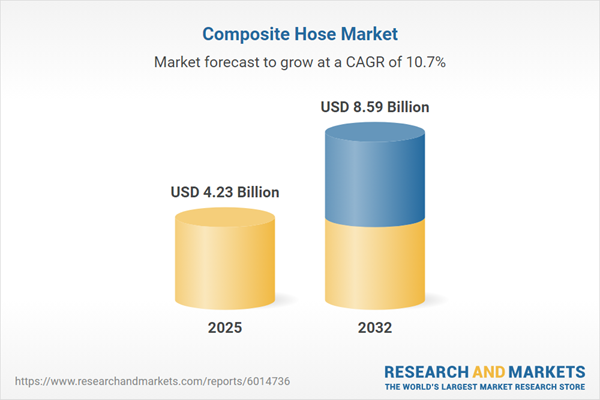Speak directly to the analyst to clarify any post sales queries you may have.
The composite hose market is adapting rapidly as senior leaders require advanced, regulation-compliant solutions that deliver reliable safety and operational continuity across diverse industrial environments. As operational challenges escalate, procurement decisions increasingly hinge on selecting hoses that align with strategic and regulatory demands.
Market Snapshot: Composite Hose Market Growth Outlook
The composite hose market demonstrates robust progress, with a 2024 value of USD 3.81 billion and projected growth to USD 8.59 billion by 2032. Anticipated expansion is underpinned by a compound annual growth rate of 10.66%. This upward trend is driven by the growing emphasis on safer and more efficient fluid management for industries that include chemical processing, oil and gas, maritime transport, and food and beverage production. Industry investments are targeting technological advancements that support strict regulatory compliance and operational adaptability, with executive focus on certified hoses and procurement strategies that enhance competitiveness within complex supply chains.
Scope & Segmentation: Composite Hose Market
- End-User Industries: Composite hoses are critical for chemical manufacturing, food and beverage operations, marine bunkering, and oil and gas installations. They ensure secure fluid transfer and are valued where strict safety and operational protocols are necessary to minimize risk and meet compliance mandates.
- Material Composition: Options such as PTFE, PVC, engineered rubber compounds, and silicone deliver broad compatibility with harsh chemicals and wide temperature variations. This versatility allows end-users to meet demanding process standards while maintaining system integrity under challenging environmental conditions.
- Construction Types: Steel wire, textile braids, and multi-layer composite reinforcements balance flexibility with mechanical strength. These constructions suit applications from standardized operations to those with elevated purity requirements or heightened resistance to mechanical failure.
- Geographic Regions: Regional adoption is shaped by a varied regulatory landscape. In the Americas, compliance frameworks drive procurement. Europe focuses on environmental standards and scalability. The Middle East and Africa deploy composite hoses widely across petrochemical and industrial sectors, while Asia-Pacific is experiencing rapid uptake aligned with infrastructure expansion and manufacturing sector growth.
- Leading Companies: Organizations such as Continental AG, Parker Hannifin Corporation, Trelleborg AB, Eaton Corporation plc, Bridgestone Corporation, Kuriyama of America, Toyobo Co., Ltd., Semperit AG Holding, Gates Corporation, and Yokohama Rubber Co., Ltd. play pivotal roles in innovation and supply chain stability, establishing globally recognized performance and safety benchmarks.
Key Takeaways: Strategic Insights for Senior Leaders
- Integrating composite hoses strengthens operational reliability and supports the safe transfer of hazardous or corrosive fluids, reducing the likelihood of downtime in core processes.
- Combining advanced synthetic materials with metal reinforcement extends service life and maximizes chemical resistance, contributing to fewer maintenance cycles for regulated sectors.
- Implementing sensor-enabled hose systems allows for real-time monitoring, providing early warning for preventive maintenance and enhancing overall asset safety and availability.
- Pursuing global certifications enables seamless participation in international supply chains, minimizing regulatory barriers to cross-border project execution.
- Adopting lightweight, modular hose solutions reduces installation time and waste, promoting quick system upgrades and contributing to long-term sustainability initiatives.
- Leveraging digital asset tracking and analytics equips organizations to respond quickly to regulatory changes, market shifts, and supply chain disruptions, building resilience in procurement and logistics operations.
Tariff Impact: Navigating US Trade Developments
Recent tariff developments in the United States have increased sourcing costs for polymers and metals, integral to the manufacture of composite hoses. Organizations are responding by expanding regional sourcing and diversifying suppliers to protect operational continuity and mitigate risk. These trade changes prompt a greater focus on contingency planning and agile supplier management to keep pace with evolving regulatory requirements.
Methodology & Data Sources
This market analysis draws from executive-level interviews, expert input, industry literature, trade records, and patent reviews. All findings are independently validated to ensure data reliability and align with strategic needs of senior decision-makers.
Why This Report Matters for Strategic Decision-Makers
- Identifies actionable opportunities for investment and collaboration, strengthening procurement and operational planning within the composite hose sector.
- Helps organizations anticipate and adapt to regulatory and market changes, supporting stable supply chains through market volatility.
- Supports alignment between technology selection, product planning, and operational strategy for improved agility and responsiveness.
Conclusion
The composite hose market presents clear avenues for elevating operational efficiency and maintaining regulatory compliance. With robust, independently validated insights, senior leaders are positioned to navigate risk and leverage new opportunities as the industry evolves.
Additional Product Information:
- Purchase of this report includes 1 year online access with quarterly updates.
- This report can be updated on request. Please contact our Customer Experience team using the Ask a Question widget on our website.
Table of Contents
3. Executive Summary
4. Market Overview
7. Cumulative Impact of Artificial Intelligence 2025
Companies Mentioned
The companies profiled in this Composite Hose market report include:- Continental AG
- Parker Hannifin Corporation
- Trelleborg AB
- Eaton Corporation PLC
- Bridgestone Corporation
- Kuriyama of America, Inc.
- Toyobo Co., Ltd.
- Semperit AG Holding
- Gates Corporation
- Yokohama Rubber Co., Ltd.
Table Information
| Report Attribute | Details |
|---|---|
| No. of Pages | 181 |
| Published | November 2025 |
| Forecast Period | 2025 - 2032 |
| Estimated Market Value ( USD | $ 4.23 Billion |
| Forecasted Market Value ( USD | $ 8.59 Billion |
| Compound Annual Growth Rate | 10.6% |
| Regions Covered | Global |
| No. of Companies Mentioned | 11 |








